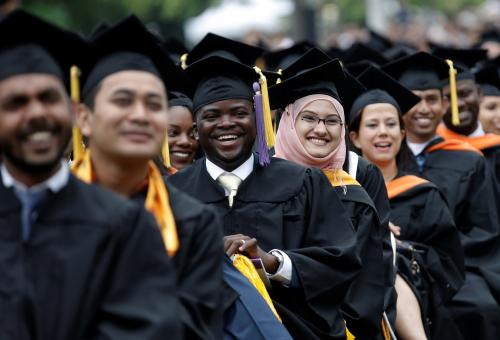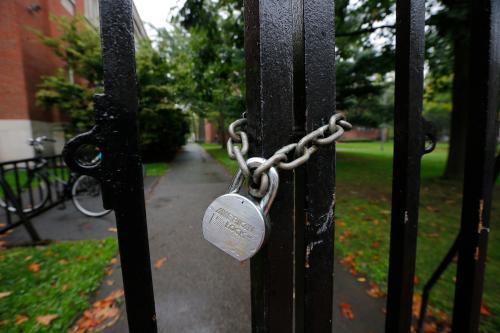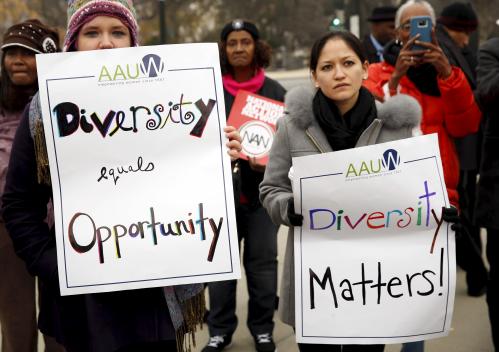The following piece is partially adapted from the book “Divided Politics, Divided Nation: Hyperconflict in the Trump Era,” a forthcoming Brookings Institution Press memoir by Darrell West.
It is shocking to read the stories about the brazen schemes wealthy individuals have used to help their children get into elite universities. There are allegations coaches were bribed to pretend certain applicants were athletes deserving of special admissions considerations. High standardized test scores were enabled through extra time provisions normally reserved for dyslexic or attention-deficit students.
During my 26 years teaching at Brown University, I never saw anything as brazen as these activities. But I did witness examples of undue influence by the wealthy and well connected. As described in my Brookings Institution Press memoir, “Divided Politics, Divided Nation: Hyperconflict in the Trump Era,” novel forms of favoritism have arisen in regard to college admissions at many elite private institutions.
I started teaching at Brown University in 1982, and a decade earlier, the school had undergone a student-led revolution. Dissatisfaction with the status quo drove many pupils to complain about the highly structured, old-style curriculum. Fueled by the energy of the anti–Vietnam War Movement, civil rights, feminists, and environmental movements, a wave of change washed over Brown and other universities around the world.
Rather than fight the shift, the faculty, trustees, and administrators adopted a series of reforms known as the New Curriculum. This revamping did away with all core courses and distribution requirements that forced students to take courses in a variety of areas. The alteration meant undergraduates would not have to take courses they dreaded, such as math, foreign languages, or natural science.
The impact of these reforms on the university was profound. When it had a structured curriculum and distribution requirements, Brown was in the middle of the pack on college ratings, at least among private liberal arts colleges. If you got the same type of education at Brown as you might get at Harvard, Stanford, or the University of Chicago, there was no reason to prefer Brown over bigger schools with more money and stronger reputations.
But when the school changed to an unstructured curriculum, no distribution requirements, and a simplified grading system, Brown became the best of that genre. It was a marketer’s dream. You want more student choice, more curricular options, and flexible requirements? Then come to Brown.
This brilliant bit of counter-cyclical programming catapulted Brown into national and international prominence and turned the university into one of the most popular schools in the country. Applications soared, and it became very difficult to gain admission. Its open curriculum and East Coast location were attractive to potential students, and thousands of applicants competed for the 1,500 slots open each year. Within a decade, around the time I arrived on campus, Brown would have an acceptance rate in the single digits and become the school of the rich and famous.
People want to think admissions decisions at elite institutions are always made on the basis of merit. And most of the time, at Brown, that was the case. Ivy League schools have rigorous admissions standards and employ dozens of people to read each file and assess the applicant’s suitability for the university. Most of each year’s class was filled with highly deserving students.
“People want to think admissions decisions at elite institutions are always made on the basis of merit.”
Yet there were exceptions to this fact. The children of the rich and famous received special treatment, as did the children of alumni. If your parent or grandparent had gone to the university, your admission chances were greatly enhanced. The thought was a family’s loyalty to the institution should be rewarded even though it created unfairness for first-generation college students. Ultimately, there would be a book by Daniel Golden entitled “The Price of Admission” that explained how Brown and other Ivies had risen to prominence in part based on “affirmative action” for wealthy donors and famous celebrities.
That book would set the agenda regarding unfairness in Ivy League admissions and years later, an independently filed lawsuit at Harvard University would act on that perception by accusing the school of unfair admissions practices. Documents unsealed during that litigation showed how Harvard privileged the applications of the wealthy, donors, legacies (that is, alumni offspring), and faculty children. As an example, the admission rate for legacies was 33.6 percent, compared to 5.9 percent for non-alumni applicants.
In addition, the university had a “dean’s list” or “director’s list” that allowed top school administrators to tip the balance of marginal applicants toward admission. The tilt could be based on any number of reasons from expectations of a donation, having a famous relative, or even as trivial as having met the applicant at a recruitment event. Under oath, the Harvard dean of admissions was forced to explain emails he had sent “suggesting special consideration for the offspring of big donors, those who have ‘already committed to a building’ or have ‘an art collection which could conceivably come our way.’”
At Brown, I saw similar practices firsthand. When the children of prominent people came to campus for admissions tours, the development office would call me and other faculty members to set up individual meetings with them. On many occasions, I met the children of famous politicians and media celebrities who wanted their son or daughter to get into Brown. I talked with them about the university, and sometimes wrote letters on their behalf describing the meeting. It was standard operating procedure at the university as well as other elite institutions to provide special treatment for offspring of the prominent and well heeled.
These practices are just some of the ways money has compromised the U.S. system and given political and economic elites special advantages. In addition to providing unfair admission advantages, these cases of undue influence have fueled widespread public cynicism and a view the system is rigged against average people. All of us need to re-examine these practices and work to maintain a merit-based playing field in the United States.






Commentary
Inside the Ivy League admissions process
March 15, 2019